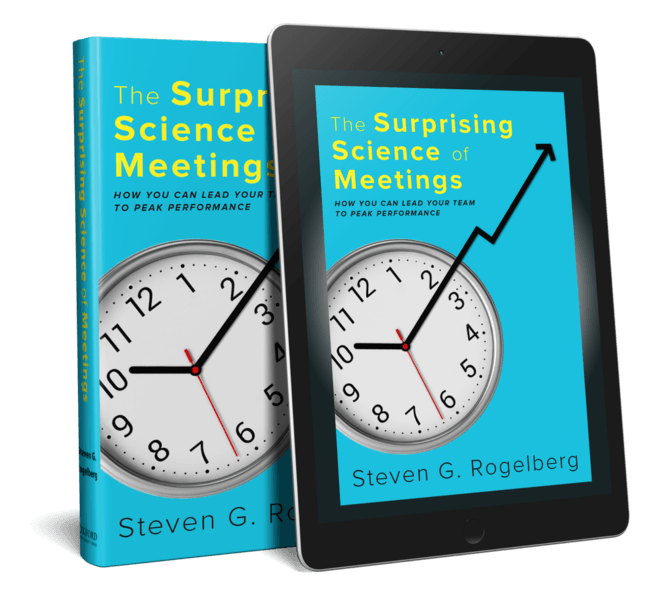An Interview with the Expert – Dr. Steve Rogelberg’s Tips for Virtual Meetings
June 9, 2020 in The Consulting Experience
By Haylee Gans, Dr. Steve Rogelberg

Now that virtual work has become the norm, we are all looking for ways to engage our employees and stay connected. Meetings are one of the few times in a work-from-home day that we have the opportunity to interact with our co-workers. Steven Rogelberg, PhD, has been studying meetings and teams for over 20 years, and is the author of the best-selling book, The Surprising Science of Meetings: How You Can Lead Your Team to Peak Performance. Dr. Rogelberg shares just how to leverage the “science of meetings” to ensure our remote meetings are running smoothly and that we don’t miss a beat out of the office!
Note that responses have been edited for length and clarity.
Let’s start with why should we care about meetings, both in general and particularly in the current environment?
We know that doing meetings wrong has a tremendously negative impact on team success, innovation, creativity, and on the individuals’ well-being and stress. In fact, experiencing a poor meeting can even result in “meeting recovery syndrome,” where employees lose additional time and productivity mentally recovering from a bad meeting.
But, doing meetings right can result in so many positive and energizing outcomes, from better decision making, to increased innovation, cohesion, agility, and resilience – these outcomes are essential as teams and organizations struggle with the working challenges of the pandemic.
What is the biggest challenge employees face in remote meetings?
Remote meetings create increased communication challenges. Without visual cues, the meeting is potentially fraught with people interrupting one another, difficulty finding a communication flow, and potential misinterpretations (e.g., sarcasm and motives are harder to detect). On top of all this, background noise coupled with poor connection quality, if present, serve to further undermine the richness of communication and the ability of attendees to coordinate their contributions.
We all know that preparation is key – so, how can we best prepare for our remote meetings?
There are many strategies we can use, but here are three of mine: don’t over invite,set time properly, and sharpen your agenda.
Remote meetings plummet in quality as size increases. Luckily, remote meetings can be readily recorded and listened to at twice the speed by attendees who don’t attend live. So, let nonessential members off the hook, and just share the recording. However – and this is key – to avoid team members who weren’t invited from feeling marginalized, give them the option to attend any future meetings on the topic if they so desire. They typically won’t take you up on it, but they will appreciate being asked.
Given our shorter attention spans right now, avoid defaulting to the hour-long meeting. Don’t hesitate to make your meetings 20 minutes, 25 minutes, etc. Dialing the meeting time back a bit also creates positive pressure. Research shows that groups operating under some level of pressure actually perform more optimally given increased focus.
As opposed to a set of topics to be discussed,try organizing the agenda as a set of questions to be answered to create focus, which is often lacking in remote meetings. By framing agenda items as questions, you have a better sense of who really has to be invited to the remote meeting. By framing agenda items as questions, you know when to end the meeting and if the meeting has been successful, the questions have been answered.
Finally, how can we keep employees engaged during the meeting?
Active facilitation is absolutely key in remote meetings. Meeting leaders must embrace the role of facilitator. Draw virtual attendees in (e.g., “Sasha, please share your thoughts”) to keep them engaged. You might even consider keeping a tally to be sure all are contributing and all voices are heard. Avoid generically asking, “Any comments?” Instead, call on people specifically. Also, don’t let people ramble, especially given shorter attention spans and shorter meetings; kindly interrupt if necessary. That is your job as a meeting leader.
It is also important to utilize tools to your advantage. Creating “presence” is important in remote meetings. We want attendees to be actively engaged. Video increases the chances of that happening. Video conferences are more effective when people can see each other’s facial expressions. Consider asking individuals to sit close to their webcam to help to recreate the intimacy of an in-person meeting. Also, realize that silence does not equal understanding or agreement. Have instant messenger or chat room technology in place, not for folks to engage in side-conversations, but for attendees to notify you during the meeting if they want to speak or indicate if they missed something. Utilizing the technological tools at your disposal helps increase attendee involvement and engagement during the meeting.
So, what does it all mean? The bottom line – there’s hope! Although it’s difficult to stay connected in a remote work environment, by using these helpful tips, we can keep our meetings productive and stay engaged with our teammates, clients, and co-workers.
How have you been keeping your virtual meetings productive? Share your experiences with us on LinkedIn?

Dr. Steve Rogelberg is the Chancellor’s Professor at the University of North Carolina Charlotte for distinguished national, international, and interdisciplinary contributions, and author of The Surprising Science of Meetings: How You Can Lead Your Team to Peak Performance.